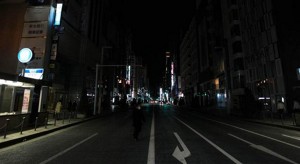 Here’s another article in this series where I squeeze meaning out of seemingly purposeless tragedy.
Here’s another article in this series where I squeeze meaning out of seemingly purposeless tragedy.
When I landed in Tokyo 2 weeks ago – my first trip here since the quake – I wondered what signs of the recent disaster might be evident. As the bus made its way from the airport into town I strained to see if there were cracks in buildings or structures in shambles lining the highway. I expected to at least see a missing window or two, if not a pile of rubble here or there, as evidence of the recent 8.9 earthquake. After all, this quake was far more intense than the buildings of Tokyo were designed to endure. (After watching the videos of buildings in Tokyo waving like blades of grass in the wind, I’m of the opinion that their durability in the face of this enormous earthquake is one of the engineering miracles of this century.)
As much as I searched, as far as I could tell everything was exactly the same as the last 100 times I’d ridden this bus route. Except, that is, for the city lights. Tokyo was noticeably darker! For example, convenience stores were plenty bright inside, but their outside lights were completely turned off. The vending machines peppering the sidewalks were glowing dimly from a few LEDs still powered up, but their main lights were also dim, making them mere shadows of the thirst-quenching meccas that normally beckon to parched commuters. And the famous Rainbow Bridge that spans Tokyo Bay, dazzling onlookers by day and night, looked rather humble as a practical number of dim bulbs illuminated only the lower edge. And I can personally attest to the fact that even the toilet seat heaters had been turned off in many establishments.
I soon discovered that this enormous, thriving metropolis of tens of millions of people had managed to reduce their power consumption by 25% since the disaster, something that I imagine many people would have claimed was impossible, or at least unrealistic, prior to the quake. While this single-minded focus on power conservation has been prompted by necessity, I was still impressed that such dramatic reductions were possible without any significant reduction in the quality of life (aside from a chilly behind in the bathroom). It struck me that if 25% reduction was possible without noticeably eroding the quality of life, then far greater reductions should be within reach if human beings were willing to sacrifice a luxury or two. In that spirit I resolved to enormously reduce my power consumption during my visit.
First thing to go was heat and air conditioning in my hotel. Even when temperatures soared to summer-like highs, I just opened the window and let in the fresh air along with the noise of the city. I limited my lighting to just what my computer screen put out, except when I had to tackle the delicate task of putting on mascara – something I hesitate to disclose lest I dispel the illusion that I’m a natural beauty.
Perhaps you think my meager efforts to conserve a few milliwatts of power don’t mean much, but the noticeably darker streets of Tokyo were comforting assurance that I was not alone in my efforts. Knowing that millions of other people were consciously reducing their use of electricity encouraged me to do the same. The goal was simple and clear, and we all could be assured that our efforts were not in vain because the commitment to reduce power usage was strikingly visible everywhere.
That’s often the key to achieving what seems impossible in our projects, too. Clear, simple goals that everyone clearly knows how to support. True, a crisis brings with it a sense of urgency that change is required, but I’m determined to find ways to inspire widespread action without disaster.
I have a tendency to focus on making a big impact, but next time I’m working on a project where we need to achieve seemingly impossible results I’m going to remember that many small contributions can add up to surprisingly big cumulative results.
